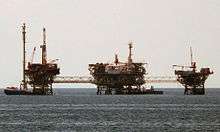Energy in Greece

Energy production in Greece is dominated by the state owned Public Power Corporation (known mostly by its acronym ΔΕΗ, or in English DEI). In 2009 DEI supplied for 85.6% of all electric energy demand in Greece,[1] while the number fell to 77.3% in 2010.[1] Almost half (48%) of DEI's power output is generated using lignite, a drop from the 51.6% in 2009.[1]
12% of Greece's electricity comes from Hydroelectric power plants[2] and another 20% from natural gas.[2] Between 2009 and 2010, independent companies' energy production increased by 56%,[1] from 2,709 Gigawatt hour in 2009 to 4,232 GWh in 2010.[1]
In 2008 renewable energy accounted for 8% of the country's total energy consumption,[3] a rise from the 7.2% it accounted for in 2006,[3] but still below the EU average of 10% in 2008.[3] 10% of the country's renewable energy comes from solar power,[4] while most comes from biomass and waste recycling.[4] In line with the European Commission's Directive on Renewable Energy, Greece aims to get 18% of its energy from renewable sources by 2020.[5] In 2013, according to the independent power transmission operator in Greece (ΑΔΜΗΕ) more than 20% of the electricity in Greece has been produced from renewable energy sources and hydroelectric powerplants. This percentage in April reached 42%. Greece currently does not have any nuclear power plants in operation, however in 2009 the Academy of Athens suggested that research in the possibility of Greek nuclear power plants begin.[6]
Tables
| Energy in Greece[7] | ||||||
|---|---|---|---|---|---|---|
| Capita | Prim. energy | Production | Import | Electricity | CO2-emission | |
| Million | TWh | TWh | TWh | TWh | Mt | |
| 2004 | 11.06 | 354 | 120 | 284 | 57.0 | 93.9 |
| 2007 | 11.19 | 374 | 141 | 284 | 63.0 | 97.8 |
| 2008 | 11.24 | 354 | 115 | 293 | 64.3 | 93.4 |
| 2009 | 11.28 | 342 | 117 | 258 | 62.5 | 90.2 |
| 2012 | 11.31 | 311 | 112 | 228 | 59.8 | 83.6 |
| 2012R | 11.09 | 309 | 121 | 226 | 61.1 | 77.5 |
| 2013 | 11.03 | 272 | 108 | 188 | 55.1 | 68.9 |
| Change 2004-09 | 2.0% | -3.4% | -2.0% | -9.1% | 9.8% | -3.9% |
| Mtoe = 11.63 TWh . Prim. energy includes energy losses
2012R = CO2 calculation criteria changed, numbers updated | ||||||
Fossil fuels
Oil and gas


Greece has 10 million barrels of proved oil reserves as of 1 January 2011.[8] Hellenic Petroleum is the country's largest oil company, followed by Motor Oil Hellas. Greece's oil production stands at 7,946 barrels per day (bbl/d),[8] ranked 90th, while it exports 1,863 bbl/d (57th)[8] and imports 496,600 bbl/d (25th).[8]
In 2011 the Greek government approved the start of oil exploration and drilling in three locations within Greece,[9] with an estimated output of 250 to 300 million barrels over the next 15 to 20 years.[9] The estimated output in Euros of the three deposits is €25 billion over a 15-year period,[9] of which €13–€14 billion will enter state coffers.[9] Greece's dispute with Turkey over the Aegean poses substantial obstacles to oil exploration in the Aegean Sea.
In addition to the above, Greece is also to start oil and gas exploration in other locations in the Ionian Sea as well as the Libyan Sea, within the Greek exclusive economic zone, south of Crete.[10][11] The Ministry of the Environment, Energy and Climate Change announced that there was interest from various countries (including Norway and the United States) in exploration,[11] and the first results regarding the amount of oil and gas in these locations are expected in the summer of 2012.[11]
A number of oil and gas pipelines are currently under construction or under planning in the country. Such projects include the Interconnector Turkey-Greece-Italy (ITGI) and South Stream gas pipelines.[2]
The Turkey–Greece pipeline is a 296 kilometres (184 mi) long natural gas pipeline, which connects Turkish and Greek gas grids completed in September 2007.
Coal
Megalopoli Mine is a large lignite and coal mine owned by the Public Power Corporation of Greece. The largest lignite and coal mine in Greece are in the area of Western Macedonia and especially in Ptolemaida.
Renewable energy
Biomass
Regulation Background
In a summary, the Greek energy market situation regarding the production of energy from biomass is presented. Renewable energy directive requires the EU to fulfill at least 20% of its total energy needs with renewable by 2020. This should be achieved through the attainment of individual national targets.[12] EU Commission allocates biomass as the third source of energy within EU after wind.[13] Greek State allocated 350 MW of electricity to biomass - bio-fuels[14]
Greek Situation Analysis
- Currently <50 MW of biomass - bio-fuels to energy are operating in Greece (Out of 350 MW).
- Feed in tariff (FIT) is 198 €/MW h.
- 20-year contract with an extension option at the end.
- There is a quite long licensing process.[15]
Wind
| EU and Greece Wind Energy Capacity (MW)[16][17][18][19] | ||||||||||||||||
|---|---|---|---|---|---|---|---|---|---|---|---|---|---|---|---|---|
| No | Country | 2012 | 2011 | 2010 | 2009 | 2008 | 2007 | 2006 | 2005 | 2004 | 2003 | 2002 | 2001 | 2000 | 1999 | 1998 |
| - | EU-27 | 105,696 | 93,957 | 84,074 | 74,767 | 64,712 | 56,517 | 48,069 | 40,511 | 34,383 | 28,599 | 23,159 | 17,315 | 12,887 | 9,678 | 6,453 |
| 12 | Greece | 1,749 | 1,629 | 1,208 | 1,087 | 985 | 871 | 746 | 573 | 473 | 383 | 297 | 272 | 189 | 112 | 39 |
See also
| Wikimedia Commons has media related to Energy in Greece. |
References
- 1 2 3 4 5 "Public Power Corporation S.A. Financial Report (January 1, 2010 - December 31, 2010)" (PDF). Public Power Corporation of Greece. 2010. Retrieved 24 October 2011.
- 1 2 3 "Energy". Invest in Greece Agency. Retrieved 26 October 2011.
- 1 2 3 "Share of renewable energy in gross final energy consumption %". Eurostat. 2008. Retrieved 24 October 2011.
- 1 2 "Sustainable development in the European Union" (PDF). Eurostat. 2009. Retrieved 24 October 2011.
- ↑ "Renewable energy >> Targets by 2020". Eurostat. Retrieved 24 October 2011.
- ↑ "Πορίσματα της Ομάδας Εργασίας της Επιτροπής Ενέργειας της Ακαδημίας Αθηνών επί του θέματος "Πυρηνική Ενέργεια και Ενεργειακές Ανάγκες της Ελλάδος"" (PDF). Academy of Athens. Retrieved 24 October 2011.
- ↑ IEA Key World Energy Statistics Statistics 2015, 2014 (2012R as in November 2015 + 2012 as in March 2014 is comparable to previous years statistical calculation criteria, 2013, 2012, 2011, 2010, 2009, 2006 IEA October, crude oil p.11, coal p. 13 gas p. 15
- 1 2 3 4 "The World Factbook – Greece". CIA. Retrieved 18 October 2011.
- 1 2 3 4 "Green Light for Hydrocarbon Exploration". Invest in Greece Agency. Retrieved 26 October 2011.
- ↑ "Μέσα στην άνοιξη οι σεισμικές έρευνες σε Ιόνιο και Ν. Κρήτη για υδρογονάνθρακες" [(Oil and gas) exploration in the Ionian Sea and Crete to start this spring]. Skai TV. Retrieved 6 March 2012.
- 1 2 3 "Ενδιαφέρον ξένων εταιρειών για υδρογονάνθρακες σε Ιόνιο – Κρήτη" [Interest from foreign companies for hydrocarbon exploration in the Ionian Sea and Crete]. Skai TV. Retrieved 6 March 2012.
- ↑ "Directive 2009/28/EC of the European Parliament and of the Council of 23 April 2009 on the promotion of the use of energy from renewable sources and amending and subsequently repealing Directives 2001/77/EC and 2003/30/EC (Text with EEA relevance)". European Union. European Union. Retrieved 13 January 2016.
- ↑ "Renewable Energy: Progressing towards the 2020 target". European Commission. European Commission. Retrieved 13 January 2016.
- ↑ "ΥΑ "A.Y./Φ1/οικ.19598"". YPEKA. Greek Ministry of Energy and Environment. 1 October 2010.
- ↑ "Biomass Situation Analysis in Greece". Buildeco. 2015. Retrieved 13 January 2016.
- ↑ EWEA Staff (2010). "Cumulative installed capacity per EU Member State 1998 - 2009 (MW)". European Wind Energy Association. Retrieved 2010-05-22.
- ↑ EWEA Staff (February 2011). "EWEA Annual Statistics 2010" (PDF). European Wind Energy Association. Retrieved 2011-01-31.
- ↑ EWEA Staff (February 2012). "EWEA Annual Statistics 2011" (PDF). European Wind Energy Association. Retrieved 2011-02-18.
- ↑ Wind in power: 2012 European statistics February 2013
